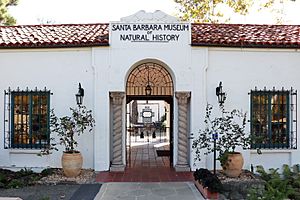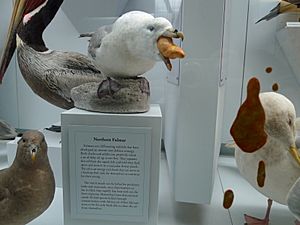Santa Barbara Museum of Natural History facts for kids
 |
|
| Established | 1916 |
|---|---|
| Location | 2559 Puesta del Sol Santa Barbara, CA |
| Type | Natural history museum |
The Santa Barbara Museum of Natural History is a cool place to learn about nature and science. It's a natural history museum located in Santa Barbara, California.
This museum is a non-profit organization. It has two main locations. The main museum is in Mission Canyon, near Mission Creek. It also has the Sea Center, which focuses on the ocean. The Sea Center is located on Stearns Wharf. In 2023, about 230,000 people visited the museum's two locations.
The museum has many indoor exhibits and outdoor areas. These spaces offer fun, hands-on ways to learn. The permanent exhibits teach about the nature of California. You can learn about local animals like plants, insects, mammals, and birds. There are also exhibits on marine life and the history of the native Chumash people. Other exhibits cover astronomy, geology, and paleontology. You can also learn about the area's special Mediterranean climate. The museum has a historic research library and the Palmer Observatory. It also has the John & Peggy Maximus Gallery, which displays over 5,000 old nature prints. The museum says it has the only full-dome planetarium on the Central Coast of California.
Contents
History of the Museum
How the Museum Started
The idea for a natural history museum in Santa Barbara began a long time ago. The first group, the Santa Barbara Society of Natural History, had a museum from 1875 into the early 1900s. Important scientists like Caroline Bingham and Sarah Paxon Moore Cooper were part of it.
A new group of people met on January 31, 1916. They wanted to create the museum we know today. An ornithologist named William Leon Dawson led this effort. He donated his large collection of bird eggs. He also gave two buildings on his property in Mission Canyon. This became the Museum of Comparative Oology. In 1918, Caroline Hazard joined the museum's board. She became one of its most important leaders and supporters.
Dawson was in charge until 1923. He left because he disagreed with the board. They wanted the museum to include more than just bird eggs. Ralph Hoffmann, a teacher and botanist, took over. Harold S. Gladwin, an archaeologist, also joined as a curator. In 1922, Caroline Hazard donated some of her land to the museum. Her sister-in-law gave money to build new structures. The museum moved to its current location and reopened in April 1923. An artist named Elizabeth Mason created dioramas showing early Native American life. Even Albert Einstein visited in 1931 and said the museum was built with "the work of love."
Later directors helped the museum grow even more. Paul Marshall Rea became director in 1933. Then, in 1937, Arthur Sterry Coggeshall took over. He had worked at famous museums like the American Museum of Natural History. Coggeshall made the museum more professional. He convinced Max Fleischmann, from the Fleischmann Yeast company, to build the Fleischmann Auditorium. Coggeshall was director for 21 years. He also helped start the California Association of Museums. Many famous artists living in Santa Barbara at the time contributed to the museum.
After Coggeshall, Dr. Vertress L. VanderHoof, a geologist, was director until 1963. Dr. Frederick H. Pough, a vulcanologist, became director in 1965. In 1972, Dr. Dennis Power, an evolutionary biologist, became the longest-serving director. He led the museum for 22 years until 1994.
Modern Museum Growth
From the 1960s to the 1990s, the museum played a big role in environmental protection. Museum scientists helped create important research programs. For example, they started the Marine Mammal Stranding Network. This network reports marine animals that wash up on beaches. They also helped with the conservation of the California condor. Museum staff also did studies for the National Park Service. These studies helped create Channel Islands National Park.
The museum has the largest collection of Chumash and pre-Chumash artifacts in the world. In 2022, the museum returned the remains of over 1,000 Chumash people to the Santa Ynez Band of Chumash Indians. This was done following a law called the Native American Graves Protection and Repatriation Act. Some of these human bones were over 13,000 years old. They are believed to be the oldest human remains found in North America. This supports the idea that early people might have traveled to the Americas by ocean.
Museum Exhibits

The museum is famous for its amazing dioramas. These displays show birds, mammals, and southern California habitats. Famous artists created the backgrounds for these dioramas in the 1930s and 1960s. The Bird Habitat Hall is very popular. It features mounted birds and background paintings by Ray Strong. The museum also has halls about marine life, geology, and Chumash Indian life. There is an art gallery with old natural history prints.
The museum has over 3 million specimens in its collections. It also has active research programs. These programs focus on marine biology, land animals, insects, anthropology, and natural history art. When you enter the museum, you'll see a huge skeleton of a 72 feet (22 m) blue whale. This whale skeleton is a famous symbol for the museum and Santa Barbara.
Temporary exhibits cover many natural history topics. Past exhibits have included dinosaurs, sharks, and antique art. There have also been exhibits like "Butterflies Alive" and "Bringing the Condors Home." The condor exhibit told the story of the California condor's decline and recovery.
The museum's Gladwin Planetarium was updated in 2005. It now has technology to show distant planets, stars, and galaxies. In 2016, the museum started a $30 million renovation project. It began with the butterfly pavilion.
The museum also has one of the largest collections of historical Native American basketry. These baskets were made by Chumash artists.
Sea Center Exhibits
The Santa Barbara Museum of Natural History Sea Center is on Santa Barbara's historic Stearns Wharf. It first opened in 1986. It was expanded and updated in 2005. The Sea Center has many cool exhibits. You can see a life-size model of a gray whale and its calf. There's a tide pool where waves rush in every 60 seconds. The Wet Deck lets you get close to the water below. You can also visit the Channel Theater, the Workshop, and the Whale Karaoke station. There's even a plastinated dolphin on display.
More to Explore

